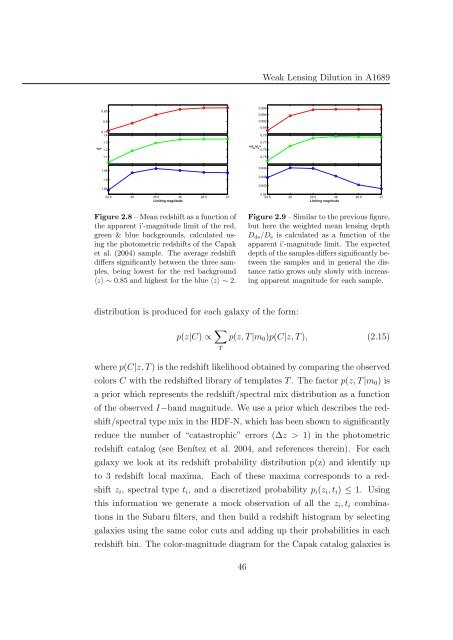Mass and Light distributions in Clusters of Galaxies - Henry A ...
Mass and Light distributions in Clusters of Galaxies - Henry A ...
Mass and Light distributions in Clusters of Galaxies - Henry A ...
You also want an ePaper? Increase the reach of your titles
YUMPU automatically turns print PDFs into web optimized ePapers that Google loves.
Weak Lens<strong>in</strong>g Dilution <strong>in</strong> A1689<br />
0.85<br />
0.8<br />
0.75<br />
1.4<br />
1.3<br />
1.2<br />
1.1<br />
0.696<br />
0.694<br />
0.692<br />
0.69<br />
0.78<br />
0.77<br />
<br />
0.76<br />
0.75<br />
1.95<br />
1.9<br />
1.85<br />
24.5 25 25.5 26 26.5 27<br />
Limit<strong>in</strong>g magnitude<br />
0.849<br />
0.846<br />
0.843<br />
0.84<br />
24.5 25 25.5 26 26.5 27<br />
Limit<strong>in</strong>g magnitude<br />
Figure 2.8 – Mean redshift as a function <strong>of</strong><br />
the apparent i’-magnitude limit <strong>of</strong> the red,<br />
green & blue backgrounds, calculated us<strong>in</strong>g<br />
the photometric redshifts <strong>of</strong> the Capak<br />
et al. (2004) sample. The average redshift<br />
differs significantly between the three samples,<br />
be<strong>in</strong>g lowest for the red background<br />
〈z〉 ∼ 0.85 <strong>and</strong> highest for the blue 〈z〉 ∼ 2.<br />
Figure 2.9 – Similar to the previous figure,<br />
but here the weighted mean lens<strong>in</strong>g depth<br />
D ds /D s is calculated as a function <strong>of</strong> the<br />
apparent i’-magnitude limit. The expected<br />
depth <strong>of</strong> the samples differs significantly between<br />
the samples <strong>and</strong> <strong>in</strong> general the distance<br />
ratio grows only slowly with <strong>in</strong>creas<strong>in</strong>g<br />
apparent magnitude for each sample.<br />
distribution is produced for each galaxy <strong>of</strong> the form:<br />
p(z|C) ∝ ∑ T<br />
p(z, T |m 0 )p(C|z, T ), (2.15)<br />
where p(C|z, T ) is the redshift likelihood obta<strong>in</strong>ed by compar<strong>in</strong>g the observed<br />
colors C with the redshifted library <strong>of</strong> templates T . The factor p(z, T |m 0 ) is<br />
a prior which represents the redshift/spectral mix distribution as a function<br />
<strong>of</strong> the observed I−b<strong>and</strong> magnitude. We use a prior which describes the redshift/spectral<br />
type mix <strong>in</strong> the HDF-N, which has been shown to significantly<br />
reduce the number <strong>of</strong> “catastrophic” errors (∆z > 1) <strong>in</strong> the photometric<br />
redshift catalog (see Benítez et al. 2004, <strong>and</strong> references there<strong>in</strong>). For each<br />
galaxy we look at its redshift probability distribution p(z) <strong>and</strong> identify up<br />
to 3 redshift local maxima. Each <strong>of</strong> these maxima corresponds to a redshift<br />
z i , spectral type t i , <strong>and</strong> a discretized probability p i (z i , t i ) ≤ 1. Us<strong>in</strong>g<br />
this <strong>in</strong>formation we generate a mock observation <strong>of</strong> all the z i , t i comb<strong>in</strong>ations<br />
<strong>in</strong> the Subaru filters, <strong>and</strong> then build a redshift histogram by select<strong>in</strong>g<br />
galaxies us<strong>in</strong>g the same color cuts <strong>and</strong> add<strong>in</strong>g up their probabilities <strong>in</strong> each<br />
redshift b<strong>in</strong>. The color-magnitude diagram for the Capak catalog galaxies is<br />
46
















